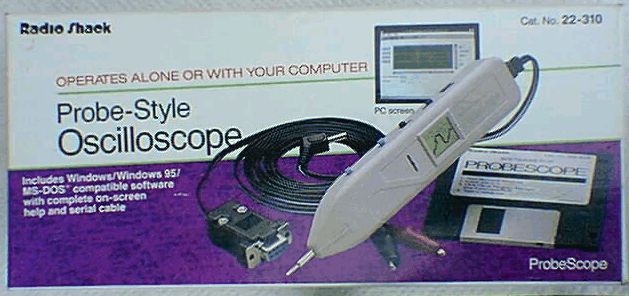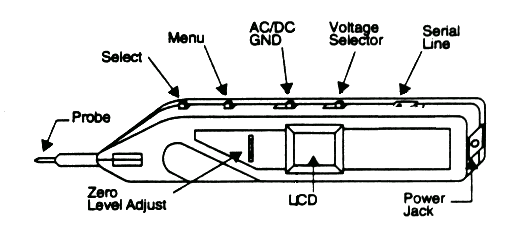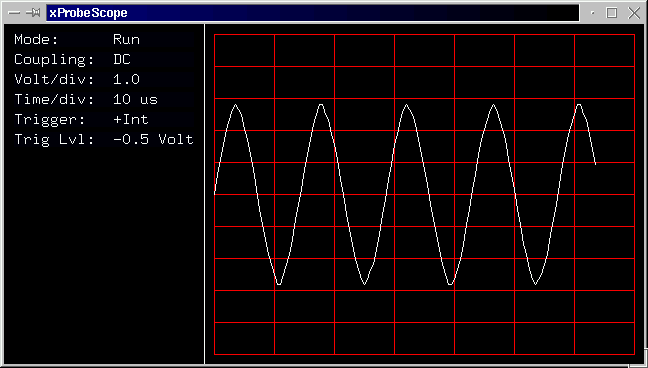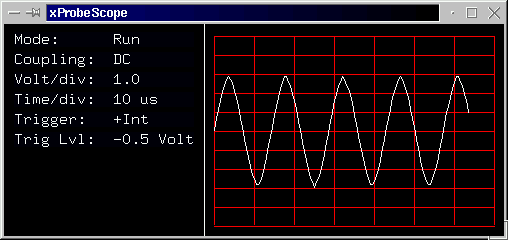
Introduction
The ProbeScope Protocol
An X-windows Program
Links to other 'scope sites
Introduction
The Radio Shack ProbeScope is a low cost digital oscilloscope with
RS-232 output. The probe is the entire oscilloscope. It samples the
signal at a rate of up to 20 million samples per second and has a six
bit analog-to-digital converter. The sample buffer is 128 bytes deep
and a small LCD displays 32 bytes of the 128 byte sample. The unit
has an RS-232 output so a larger, more complete display can be shown
on a Linux PC. It has two small push buttons: one to select a menu on
the LCD and one to select items within the menu. External switches
set the full scale voltage range and the type of coupling.
The ProbeScope is made by Wittig of Germany and is sold by Pico Technology
Limited as the OsziFOX.
The OsziFOX is available in the U.S. from the Salig Company
(http://www.saelig.com/osziFOX.htm)
.
Radio Shack
sells the ProbeScope only by catalog and it is listed in their "2000 Answers"
catalog as part number RSU11910486 with a price of $79.99. The catalog
number printed on the manual is 220-0310. An alternate part number is
910-4905.
The scope samples at a maximum rate of 20M samples/second and it does
a pretty good job for analog signals up to about 2 MHz.
Although I have other oscilloscopes, the ProbeScope is now my 'scope
of first choice. It is small, convenient, works as a DVM, and has the
frequency range to meet most of my needs.
Shown below are the ProbeScope layout and specifications which were
taken from the ProbeScope manual.

Sample Rates 50ns, 100ns, 0.5us, 1us, 5us, 10us, 50us, 0.1ms, 1ms
Input ranges 1V, 10V, 100V
No of channels 1, 1M ohm AC/DC coupled
Trigger Internal, external. Positive or negative slope
Trigger levels 6 selectable levels
Resolution 6 bit
Buffer size 128 bytes
Voltmeter AC/DC
Display 16 x 32 Back-lit LCD
Supply voltage 9V to 13V @ 13mA (cable included)
PC connection D9 to serial port (cable included)
The ProbeScope Protocol
All configuration of the ProbeScope is done on the unit itself and so it
needs only ground and Tx on the RS-232 line to send the trace samples to
the computer.
Sync bytes are sent about once a second while waiting for a trigger.
A sync byte always starts the trace and
is followed by the settings of the scope and 128 sample bytes. It
appears the byte following the 128 sample bytes is a duplicate
of the first sample byte. The ProbeScope can act as a Digital Volt
Meter and following the sample bytes are the DVM digits.
The protocol is given in the Windows help file on the floppy disk but
this file might be in error since it does not include the duplicate
byte.
Serial Data Protocol
Baud Rate: 19.200 KBaud
Data Bits: 7
Stop Bit: 1
Parity Bit: NONE
Sync Byte: 7F Hex. Several sync bytes may appear while
waiting for a trigger. The sync byte can
also used to detect whether the hardware is
attached.
Bit 6 = always set
Bit 5 = always set
Bit 4 = always set
Bit 3 = always set
Bit 2 = always set
Bit 1 = reserved
Bit 0 = Trigger Awaiting mode
Byte 1: Switch Setting Byte
Bit 6 = not used
Bit 5 reset = AC
Bit 4 reset = DC
if Bit 4 and 5 are reset = Gnd
Bit 3 set = 100 Volt
Bit 2 set = 10 Volt
if Bit 2 and 3 are reset = 1 Volt
Bit 1 = not used
Bit 0 = not used
Byte 2: Timebase Definition Byte
0 = 50ns 6 = 50µs
1 = 100ns 7 = 0.1ms
2 = 0.5µs 8 = 0.5ms
3 = 1µs 9 = 1ms
4 = 5µs
5 = 10µs
Byte 3: Trigger Definition Byte, true if set
Bit 6 = not used
Bit 5 = +INTERN
Bit 4 = -INTERN
Bit 3 = +EXTERN
Bit 2 = -EXTERN
Bit 1 = not used
Bit 0 set =SINGLE
Bit 0 reset =RUN
if Byte & 7E Hex = 0 = AUTO
Byte 4: Trigger Level Byte, true if set
Bit 6 = not used
Bit 5 = -0.3
Bit 4 = -0.1
Bit 3 = +0.1
Bit 2 = +0.3
Bit 1 = +0.5
Bit 0 = not used
if Byte = 0, lvl=-0.5
Bytes 5-132: Signal Bytes
Valid Values available from 0 to 3F Hex.
Byte 133. Duplicate of first signal byte (?)
(not included in protocol in the help file)
Byte 134. DVM Value (100), 0-9
Byte 135. DVM Value (10), 0-9
Byte 136. DVM Value (1), 0-9
Byte 137. DVM Flags, true if set
Bit 6 = not used
Bit 5 = not used
Bit 4 = not used
Bit 3 = minus flag set
Bit 2 = reserved
Bit 1 = overflow flag set
Bit 0 = underflow flag set
Here, pproto.c, is a simple program which
demonstrates the
protocol used by the ProbeScope. The program opens a serial port and
loops reading and displaying the trace data. It displays the heading
information in both hex and in English. The samples are displayed in hex.
The duplicate and DVM bytes after the samples are also printed in hex.
The program implements a state machine. Since the program could start
reading bytes in the middle of a sample, we start by looking for a sync
byte. Once the sync byte is found we start looking for the start of a
trace. Once the trace starts we count 137 bytes to get to the end of
the trace. This program is the foundation upon which the Xlib program,
xProbeScope, is built. The program might be a good place to start if you
would like to build a dedicated application using ProbeScope.
The program has just a single file, pproto.c, and is compiled
with the command:
gcc -o pproto pproto.c
The program requires a single command line argument which specifies
the serial port to use for access to the ProbeScope. An invocation
might appear as:
./pproto /dev/ttyS1
Xlib Program for ProbeScope
Here, xProbeScope.c, is an Xlib program
which reads samples from the serial port attached to ProbeScope and
displays the values on an X display. The program is based on the
pproto program which is described in the previous section.
The program is a fairly simple example of an Xlib program which
uses select() to multiplex the X display and characters from a
serial port.
The program has just a single file, xProbeScope.c, and can be compiled
with the command:
gcc -O2 -Wall -I/usr/include/X11 xProbeScope.c -L/usr/X11R6/lib -lX11 -o xProbeScope
The program requires a single command line argument which specifies
the serial port to use for access to the ProbeScope. The program is
terminated by any key hit. An invocation and display might appear as:
./xProbeScope /dev/ttyS1

You can change the scale factors in the program to get different
size displays. The above display was with scale factors of 3 pixels
per sample (horizontally) and 5 pixels per LSB (vertically) .
This means that the data display is (5 * 64) pixels high and (3 * 128)
pixels long.
#define SCALE_X 3
#define SCALE_Y 5
Here is the display with scale factors of 2 and 3 pixels.

Links to other oscilloscope sites
ProbeScope:
http://www.RadioShack.com/ -- (online manual, search on ProbeScope)
http://www.saelig.com/osziFOX.htm
Oscope:
http://xoscope.sourceforge.net/
-- the definitive Linux oscilloscope
Bit Scope:
http://www.bitscope.com/
http://www.circuitcellar.com/library/print/0898/Jackson97/5.htm
-- Circuit Cellar Article 8/98
Quality Kits:
http://www.qkits.com/serv/qkits/velleman/pages/K7105.asp
-- serial interface
http://store.qkits.com/moreinfo.cfm/K8031
-- parallel interface
XPortShot
http://www.carrotworks.com/software/xpshotrt/
- uses /dev/dsp and Gtk+
Tek_Snapshot:
http://secure.netroedge.com/~phil/tekscope/ -- Tektronix TDS-200!!



